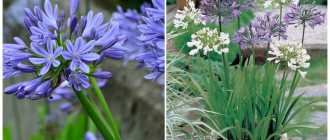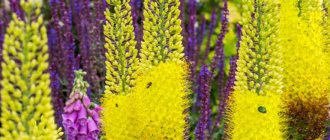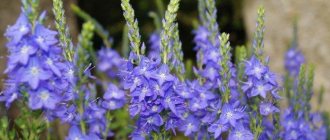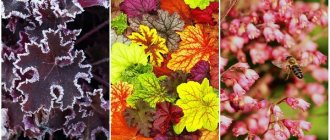Scabiosa will decorate any, even the most unremarkable, place in the garden. This is a delicate plant, the flowering of which is associated with simplicity, lightness, and grace. Its color scheme is varied, the colors are discreet. The aroma is subtle and attracts bees. Scabiosa has become a godsend for all gardeners: growing from seeds is not difficult, which is why in a short time any area turns into a beautifully flowering paradise.
Scabiosa: growing from seeds
Botanical description
Scabiosa is an annual or perennial herbaceous plant belonging to the Honeysuckle family. Its erect, leafless stems reach a height of up to 1 m and can become woody at the base. For this reason, the plant is also classified as a subshrub. The leaves are pinnately dissected or serrated, collected in a basal rosette.
Scabiosa surprises with its variety of varieties
The inflorescence is the head (in some varieties flattened), consists of individual small flowers in the center and larger ones at the edges. The inflorescence is bordered by a crown of flowering leaves. Large anthers of the stamens stand out against the background of delicately colored petals. Flowering occurs at the end of June and until September - the period when most summer flowers have faded, and autumn ones have not yet come into their own.
REFERENCE. According to one version, Scabiosa translated from Latin means “itching, scabies.” It is believed that in the past such symptoms were treated with one of the species of this plant. The crop is popularly known as scabious cornflower, cone cornflower, button grass, pincushion, devil's root.
The distribution area is the countries of Africa, Europe and Asia, but mainly the Mediterranean. In Russia, the flower grows well in the Caucasus and is found in the middle zone and Southern Siberia. In colder regions it is grown indoors. In general, the plant tolerates frost well and tolerates hot weather. Looks good in group plantings, less often planted in individual compositions.
Scabiosa in the vicinity of other flowers
Prices for scabiosa seeds
scabiosis seeds
Garden forms and varieties
Based on natural species of scabiosa, numerous varieties with improved characteristics have been bred - larger inflorescences, intense color, long-lasting flowering. The work of breeders with the following species turned out to be the most fruitful.
- From Caucasian scabiosa came highly decorative varieties of blue-violet shades - Blauer Atlas, Kleeve Grives, Morheim Blue, Nachtfalter. Prominent representatives of this group of scabiosa are the Miss Wilmotg and Alba varieties with large white flowers.
- On the basis of Japanese scabiosa, beautiful border perennials of the varieties Ritz, Romantika, and Blue Diamond were bred.
- Scabiosa purpurea has numerous varieties - the varieties are distinguished by their rich color and large double inflorescences. The Douglas, Dessert series, Scarlet, Blue Mon, and Rose Cascade varieties are popular among gardeners.
- Pigeon scabiosa in cultivation is represented by the popular variety Pink Mist, which, thanks to its low compact bush, is widely in demand as a perennial border plant.
This is interesting! Florists love to include delicate touching flowers in wedding bouquets. Particularly popular is star scabiosa (stellata), a variety with soft lilac, cream and white flowers.
The best varieties
Currently, there are up to 100 species of scabiosa, some of them relatively recently were allocated into a separate genus - Korostavnik. In general, most crop varieties are obtained through selective breeding and are considered garden varieties not found in nature.
Scabiosa caucasica
The plant is distributed in the mountains of the Caucasus, Turkey, and Iran. It is distinguished by large inflorescences up to 7-8 cm, densely located on stems 60-70 cm high. The color scheme is shades of purple, long-term flowering - from July to September. It is a perennial, but can be grown as an annual crop. Hybrid forms that produce white, pink, blue, purple flowers are popular - Nachtfalter, Fama, Compliment, Blauer Atlas, Perfecta and others.
Caucasian scabiosa is used more often than other species in landscape design:
- Included in mixborders, ridges, alpine slides;
- Planted along hedges and paths;
- Create solo compositions in separate containers;
- Grown for cutting for bouquets.
Scabiosa caucasia Fama White
Scabiosa japonica
A perennial plant native to the Japanese islands. A frost-resistant species that is perfectly cultivated as a biennial in central Russia. Low-growing due to natural growing conditions - up to 60 cm. Some varieties do not exceed 20 cm. Flowers of red and pink shades are about 5 cm in diameter. Flowering is bushy, uniform, lasts from late June to September.
Scabiosa japonica Pink Diamonds
Scabiosa japonica Romance
Scabiosa yellow
Originally from Europe, however, it is quite rare in Russia - in several regions it is listed as a wild species in the Red Book. A fairly large perennial, reaching a height of 1 m under favorable conditions. The stems are erect and powerful, but require additional support in strong winds. The flowers are pale yellow and peak in late summer. In landscape design, it is usually used as a backdrop for more colorful crops.
Scabiosa ochroleuca Moon Dance
Scabiosa ochroleuca Pixie Yellow
Scabiosa stellata
It is an annual plant also known as Scabiosa stellata. What is valuable here is not so much the pale blue flowers as the unusual bracts that form after the petals fall. This is what distinguishes stellata from other species - beautiful balls consisting of golden bracts, shaped like paper funnels. The culture looks great in any mixed composition, be it a modest bouquet or a mixborder. Its height is no more than 60 cm.
Scabiosa stellata after flowering
Bouquet with stellata
Scabiosa purpurea
Annual, less often biennial crop. Valued for its brightly colored burgundy flowers; in some specimens the color can be close to black. The plant has powerful pubescent stems up to 110 cm in height, inflorescences about 7-8 cm - they emit a strong aroma. Some hybrids are undersized. Unlike other species, purple does not tolerate negative temperatures, so it grows well in southern conditions. Flowering is long - up to 2 months, starting in July. In Europe it is known as the “flower of mourning” or “Egyptian rose”.
Scabiosa atropurpurea Ace of Spades
Scabiosa atropurpurea Chile Black
Scabiosa terry
May refer to any of the above types. Its varieties have large, well-pubescent inflorescences, the color of which varies depending on the variety. Among them are Fruit Ice, Lavender Lady, Crystal and others. Terry scabiosa is in demand in landscape design and bouquets.
Fruit ice mixture
Video - Scabiosa
Use in decoration, combination with other cultures
Low-growing varieties of scabiosa are often used as solo border plants and in compositions for mixborders. In mixed flower beds they combine beautifully with dwarf irises and hostas. White and blue varieties look stunning in the company of white lobularia. Purple varieties are recommended to be combined with so-called rural garden crops. These are cornflower, Fassin's catnip, various varieties of phlox (especially paniculata), yellow yarrow, and gypsophila. Other successful flower bed partners include pearl anaphalis, Missouri evening primrose, various types of asters, especially chamomile and perinean, as well as oak sage.
Reproduction methods
In nature, scabiosis reproduces by self-seeding. In culture, three methods are practiced:
- Seeds. The method is suitable for annual and perennial species in any climate. For this purpose, 2-3 strong peduncles are left on the rosette until the seeds are fully ripened. Collect seeds in the fall, put them in a cotton bag and bury them in damp sand. The container with seeds and sand is put away in the cold, for example in the basement. With this storage method, seed germination lasts up to 3 years;
- Seedlings. The essence is the same - sowing seeds, but not in beds, but in temporary containers. When the seedlings become stronger and the weather becomes favorable, they are planted in open ground.
Root system of young scabiosa
- Dividing the bush. This method is practiced only for perennials with an overgrown root system. The root is divided into 2 parts with a shovel, after which each of them is transplanted to a new place. In this case, both parts together with the root should have a pair of sprouts. This method is used to “renew” old bushes whose flowering has become sparse. The work should be carried out in the spring before the growing season begins.
Prices for seedling boxes
seedling boxes
Reproduction of scabiosa by dividing the bush
How to divide a scabiosa bush photo
Overgrown bushes (at least 3 years old) can be propagated vegetatively, namely by dividing the rhizome. In the spring, carefully dig up the bush, divide it into several parts (each division should contain a full-fledged part of the rhizome and growth buds) and plant it.
Growing conditions
Under natural conditions, scabiosis is common on the slopes of mountains, its individual species are found even at an altitude of 2000 m. But it also grows well in meadows, on the edges of forests and wherever the soil is well drained and has a neutral or alkaline reaction. The composition of the soil does not play a big role. It is only important to remember that stagnant moisture and acidic soil are destructive for the plant.
Wild scabiosa is adapted to unfavorable conditions. It easily tolerates drought and exposure to direct sunlight. It grows well in partial shade and overwinters under snow. Ornamental plant varieties have inherited most of the listed qualities and are therefore considered very unpretentious.
Wild scabiosa
ON A NOTE. In culture, scabiosa is grown in open sunny areas, possibly on hills or on southern slopes where there is no flooding. The site must be protected from prevailing winds, as the plant is sensitive to gusts of air.
Time to sow
Scabiosa is planted with seeds in the spring, when the ground has already warmed up a little under the sun. The optimal time is mid-April, if the winter is not long. In the south, you can start sowing at the end of March, around the same time as carrots and beets. There is no need to be afraid of frost; the seeds are not afraid of the cold.
In regions with late spring, scabiosa is planted using seedlings. In this case, seeds are sown for forcing in a greenhouse at the beginning of March or even at the end of winter. It is also practiced to sow before winter, in which case the first shoots will appear a couple of weeks earlier.
The exact sowing time is determined by the climatic characteristics of the region
How to prepare the ground for scabiosis
Scabiosa does not tolerate heavy, clay soils. She needs a light, nutritious substrate in which her roots will “breathe”. Therefore, if possible, prepare the area for sowing in advance so that by spring the organic matter added to the soil will rot and release all the necessary nutrients. Along with organic fertilizers (for example, compost), you can add a little gravel and sand to the soil (2-3 buckets per 1 m2) - this will make the growth conditions closer to natural.
REFERENCE. If it is planned to sow the plant before winter, the site is dug up approximately 30 days before the main work.
Wood ash reduces soil acidity
Since scabiosa prefers slightly alkaline soils, it would be useful to add a little wood (about 200 g/m2) or peat ash (350 g/m2) to the soil. Instead of ash, you can use slaked lime or dolomite flour. From an environmental point of view, dolomite flour is better than lime, although the effect of its use is noticeable somewhat later.
Prices for slaked lime
slaked lime
How to prepare seed
Preparing flower seeds is not a mandatory procedure before sowing, however, a few simple techniques will significantly increase their germination and help grow healthy seedlings:
This is what scabiosa seeds look like
Collecting seeds and organizing wintering
Scabiosa seeds are collected at the end of August. To ripen the seeds on the stems, the flower stalks are tied with gauze bags to prevent spontaneous spillage onto the soil. After the seed heads have completely dried, the stems are cut off, the bags are removed and the seeds are poured out. Store seeds in paper bags in a dry place. Scabiosa seeds can remain viable for up to 4 years.
Perennial species after flowering and drying of the foliage are cut back to the soil surface. Scabiosa is able to overwinter in open ground without shelter, but some hybrid varieties need to be covered for the winter with a layer of dry foliage or straw. In spring, the cover is removed and the soil is loosened.
Planting scabiosa in the ground
Sow the seeds in open ground when the ground has warmed up a little under the sun's rays. But even if the temperature still drops below 0°C, you don’t have to worry: the plant will tolerate frost just fine. The entire sowing process looks like this:
Table 1. Planting scabiosa in the ground
| Action | Description |
| The soil is loosened in advance, simultaneously removing sprouted weeds. | |
| Make shallow beds and moisten them. | |
| The seeds are laid out maintaining the optimal distance between them: for low- and medium-growing varieties about 20-30 cm, for tall varieties - 30-40 cm. | |
| The seeds are not planted deep into the soil; they are only sprinkled on top with soil mixed with compost. The first shoots will appear in 2 weeks, and after another 2-3 months flowering will begin. Crops need to be regularly moistened until the first shoots appear. |
Sowing seeds for seedlings
Forcing seedlings is important in cold regions. In this case, the seeds are sown in containers of different sizes filled with a nutrient substrate - this can be garden soil mixed with organic matter, or universal soil from the store. The soil is moistened, seeds are placed in it and covered with polyethylene. The containers are left at a temperature of about 15°C. Every day, the crops are ventilated for half an hour and the soil moisture is monitored. When the first shoots appear, the polyethylene is removed and the containers are placed in a well-lit place. Picking is carried out when the plants have 3-4 true leaves. You can read how to properly pick seedlings in our article.
Healthy scabiosa shoots
A few weeks before planting in open ground, the seedlings are hardened off. To do this, it is enough to ventilate it in the cold for an hour or half an hour, for example, on a balcony. The time spent in the cold is increased gradually. The seedlings are transplanted to a permanent location in late spring or early summer. The site must be prepared in advance. When planting, be sure to maintain the above distance between plants.
Annuals - scabioses
Dark purple scabiosa (Scabiosa atropurpurea)
Annual, less often biennial, 30-80 cm high. Fragrant flowers are usually dark purple, but there are varieties with purple, pink or white flowers. Blooms from late July until frost.
Scabiosa dark purple is less cold-resistant than other species. It is sown for seedlings in March - early April, or in the ground in early May.
Scabiosa dark purple
Popular varieties of dark purple scabiosa:
scabiosa Blue Moon - pale blue inflorescences; scabiosa Rose Cackade - pink; scabiosa Monarch Cockade - a mixture, large, double inflorescences of various colors.
Scabiosa stellata
An annual species native to Southern Europe. Plants are 30-60 cm high. The flowers have an unusual appearance, collected in small spherical inflorescences. The species is decorative during the fruiting period.
Propagated by seedlings in April and direct sowing into the ground in May. The seeds do not germinate quickly and for a long time (like all scabioses).
Scabiosa stellata
Cultivars of annual scabiosis
The Scabiosa HOOP SCOOP™ series is known for its unique flower shape and vibrant colors. The variety series is named 'Scoop', which can be translated as “ice cream ball”. The height of the plants in the series is 50-60 cm. Zone 9 (up to 0ºС).
Varieties: Marshmallow Scoop, Blackberry Scoop, Vanilla Scoop and Cherry Vanilla Scoop. For example, Scabiosa Strawberry Scoop has white flowers with a dark pink center, Lavender Scoop has lavender flowers with a white center, Cherry Vanilla Scoop has purple flowers with white tips, and Tutti Frutti Scoop has red flowers.
Scabiosa care
Since scabiosa is unpretentious, its care is minimal, although there are still a few nuances:
- Watering should be infrequent, in moderate quantities - it is better to “not top up” than to “overfill”. The signal for hydration will be a well-dried top layer of soil;
- Loosening the soil should be regular to ensure access of air to the soil. At the same time, weeds are pulled out;
- Fertilizing can be carried out throughout the entire flowering period. This will help increase the size and brightness of the inflorescences. Scabiosa “loves” potassium and phosphorus, so potassium salt and superphosphate are used for feeding;
Fertilizers for scabiosa
Trimming faded blossoms stimulates the growth of new ones.
Diseases and pests
Scabiosa is considered a crop resistant to harmful microorganisms. But violation of agricultural technology can upset the balance of the plant’s microcosm, as a result of which it may die. Known enemies of scabiosa are:
Table 2. Scabiosa pests
| Pest | Description |
| Powdery mildew | This is a fungus that develops intensively in conditions of high humidity 60-80% and at low temperatures - up to 20°C. It looks like a white coating on the leaves that quickly spreads throughout the plant. To prevent scabiosis, spray it with whey, wood ash solution or iodine solution. In advanced cases, fungicides will come to the rescue. |
| Root rot | Known as Blackleg, it is a fungal disease in which the root and part of the stem turn black and then rot, causing the death of the entire plant. The fungus forms under conditions of excessive moisture, possibly in poorly sterilized soil. As a preventative measure, moderate watering and reasonable application of fertilizers to the soil are recommended. For treatment - a fungicide, for example, Bordeaux mixture. |
| Mealybug | Or the felt louse, popularly known as the “shaggy louse” - a pest that sucks the cell sap of plants. Its activity leads to a slowdown in the growth of the crop and subsequently to its complete death. The life process of the pest is accompanied by the release of honeydew - a favorable environment for the development of the fungus. It is better to combat it immediately with insecticides, such as Admiral, Inta-vir, Aktara, etc. |
Scabiosa is a beautiful plant and there are usually no problems with growing it. Its simple flowering will delight you for many years, both in individual compositions and among variegated flower beds.
Diseases and pests of scabiosis
The plant is quite resistant to many diseases of garden flowers.
However, wet summers or excessive watering provoke the appearance of powdery mildew on the leaves of scabiosis and root rot.
Diseased bushes are sprayed with a light pink solution of potassium permanganate and the soil under the plants is spilled or treated with solutions of fungicides - foundationazole, oxychome or topaz.
Among the pests of scabiosis, gardeners call the larvae of the flower moth, which gnaw on juicy greens.
Sometimes plantings of perennial plants suffer from voles.
Autumn care, seed collection and wintering
Annual species of scabiosa are dug up and thrown away in the fall. If necessary, seeds are collected at the end of summer. Select suitable inflorescences and tie them with gauze to prevent self-seeding. When the seed pods are completely dry, they are cut off. The seeds are poured out of the boxes and stored in paper bags in a dry place.
Perennials are left to overwinter on the site. After flowering has finished and the leaves have dried, the stems are cut to soil level. Scabiosa can remain without shelter. But hybrid varieties can freeze. Therefore, for the winter they are covered with dry leaves or straw. In spring the cover is removed.
Decorative qualities
Perennial phlox flowers
The gentle elegant beauty of scabiosa is used in landscape design when creating flower beds, borders, alpine slides, and ridges. This flower combines harmoniously with field daisies, cornflowers, phlox, and cereals, forming a natural corner in a landscape style. Exquisite ensembles are created in flower beds, using plants of the same height and choosing shades in a single color scheme. Flower beds of different heights look impressive if you place a low-growing Armeria or Iberis next to the scabiosa.
Scabiosa varieties with tall stems are cultivated for cutting. They retain a fresh decorative appearance for a long time. This flower is combined in a bouquet with a variety of plants, focusing on the effect created.











